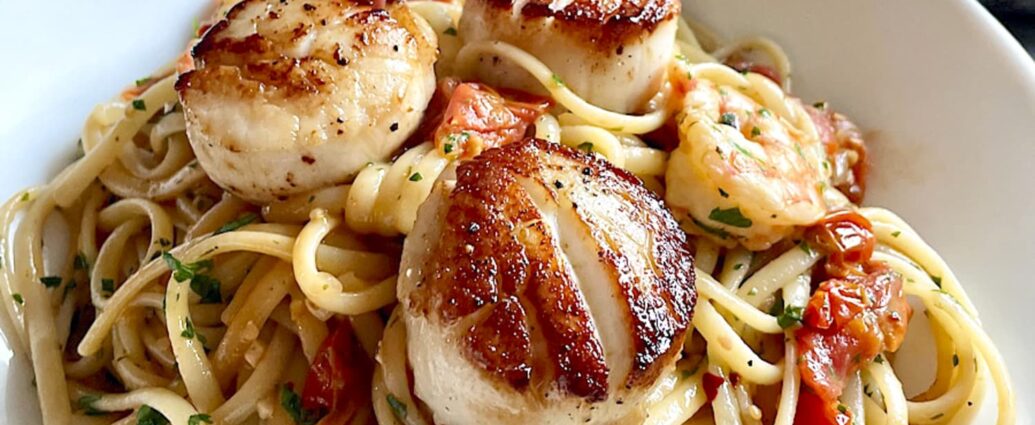Seafood pasta often gets pegged as a dish reserved for candlelit restaurant tables, accompanied by wine and a hefty price tag.
That perception deserves a solid shake-up. It’s entirely possible, and surprisingly simple, to recreate the same level of flavor and presentation in your own kitchen.
The magic of seafood pasta lies in its balance: it delivers complexity in taste, elegance in presentation, and simplicity in preparation.
With the right ingredients and techniques, any home cook can serve up seafood pasta that rivals the professionals.
15-Minute Magic: Quick & Elegant Recipes
Fast meals can still deliver bold flavor and elegant presentation. Two standout seafood pasta recipes prove that a lack of time doesn’t mean compromising on quality.
Both dishes rely on pantry staples and minimal prep while still feeling restaurant-worthy.
To help simplify preparation, key steps and ingredients are outlined in bullet points under each recipe.
The Big Man’s World Marinara-Based Pasta

A simple marinara sauce pairs seamlessly with a seafood medley, bringing forward natural sweetness and briny depth.
The dish is ideal for weeknights when time is short but expectations are high.
Key steps and ingredients:
- Sauté 3–4 minced garlic cloves in 2 tablespoons of olive oil over medium heat.
- Add 1 can (14–15 oz) of crushed tomatoes and a pinch of salt. Let simmer for 5–7 minutes.
- Toss in 2 cups of thawed seafood mix—shrimp, scallops, and squid work beautifully.
- Cook pasta (linguine or spaghetti) in salted water, reserving ½ cup of pasta water before draining.
- Add drained pasta and reserved pasta water to the sauce. Toss until coated.
- Garnish with chopped parsley and a drizzle of olive oil.
Flavors meld quickly, and the presentation feels effortless yet polished. One pan and one pot later, dinner is done.
Woman’s World Quick Mix Pasta

Designed for convenience, this version brings together frozen seafood and pantry staples to deliver a warming, spicy dish with minimal cleanup.
A quick toss of canned tomatoes and herbs turns basic ingredients into something memorable.
Steps to bring it together:
- Heat 2 tablespoons of olive oil in a skillet and add 2–3 cloves of minced garlic.
- Pour in 1 can (14–15 oz) of diced tomatoes. Simmer for 3–4 minutes.
- Stir in 2 cups of frozen seafood mix. Cook uncovered for 6–7 minutes or until seafood is heated through.
- Add salt to taste and ½ teaspoon of red pepper flakes for a kick.
- Meanwhile, boil pasta (penne or linguine) until al dente. Drain and add directly to the sauce.
- Garnish with torn basil leaves or lemon zest for brightness.
Meals like these highlight how seafood pasta can feel luxurious without burden. Perfect for last-minute guests or solo indulgence after a long day.
Restaurant Secrets at Home
Achieving restaurant-level results at home comes down to mastering a few smart methods.
Building flavor happens in stages, not in one big dump of ingredients. Timing, layering, and balance shape the final result.
Start with aromatics. Garlic and onion form the backbone of most great pasta dishes. Toss them into hot oil and they’ll bloom with flavor. That quick sizzle unlocks their natural sugars and sends a wave of aroma through your kitchen. Keep the heat moderate—burnt garlic will ruin the base.
Herbs and garnishes often get treated like an afterthought. Big mistake. These final touches brighten a dish and give it complexity.
Use these as finishing flourishes:
- Chopped parsley – brings a clean, slightly peppery note
- Fresh basil – adds sweet, soft herbaceous tones
- Lemon zest – sharpens the flavors and cuts through any heaviness
Sauce texture matters. Pasta water is liquid gold. That starchy water left after boiling pasta isn’t waste—it’s essential. Adding a splash while combining the pasta and sauce helps emulsify everything into a silky coating.
Why pasta water works:
- Binds oil and water-based ingredients
- Adds body without extra fat
- Makes sauces cling instead of slide off
Another move that separates amateurs from pros is deglazing. After sautéing shrimp or garlic, brown bits stick to the bottom of the pan.
Don’t scrape them away, use them. Add a splash of white wine, broth, or even lemon juice. The liquid lifts those browned bits into the sauce, creating complexity with no extra effort.
Deglazing liquids that work well:
- Dry white wine
- Seafood or chicken broth
- Lemon juice for brightness and acidity
Balance matters most. Cream, butter, and oil offer depth, but too much can weigh the dish down. Acidic elements like wine or citrus balance richness and sharpen flavors. It’s that contrast that gives seafood pasta its elegance. Clean, fresh, and bold—without being heavy.
Southern Inspirations
Southern cuisine blends heritage and bold flavor, and when paired with seafood pasta, the results become both familiar and inventive.
Coastal influence meets hearty countryside tradition, turning standard pasta dishes into comforting, flavor-packed meals that speak with a distinct Southern voice.
Every dish feels intentional, layered, and rooted in local pride.
Cajun Shrimp Boil Pasta

Cajun Shrimp Boil Pasta brings together the boldest parts of a Louisiana seafood boil and fuses them with the comforting slurp of linguine. Instead of a pot dumped over newspaper, this version offers structured bites with the same smoky spice and soul-warming satisfaction.
Every ingredient works overtime, shrimp bring sweetness and brine, while andouille sausage contributes depth and smokiness. Corn adds a subtle crunch and pop of freshness, and Cajun spices make sure the dish punches with flavor in every forkful.
Start by sautéing sliced andouille sausage until browned and crispy. The rendered fat infuses the pan with flavor. Add shrimp tossed in Cajun seasoning, letting them cook just until opaque. In another pan, boil linguine until just shy of al dente—saving a bit of pasta water for later.
A quick sauce comes together using:
- Garlic and onion: sautéed in olive oil to create a savory base
- Corn kernels: fresh or thawed frozen, added for texture and balance
- A splash of lemon juice: sharpens flavors and offsets richness
- Reserved pasta water: creates cohesion between sauce and noodles
Once the components are ready, everything gets folded together—shrimp, sausage, corn, pasta, and sauce. A final toss coats the linguine, pulling the dish together into a cohesive medley.
Top with chopped parsley or scallions for brightness and a pinch of red pepper flakes for extra heat.
Shrimp and Tomato Cream Sauce

A velvety tomato cream sauce creates a lush backdrop for sautéed shrimp, delivering a balance of bold flavor and satisfying texture. The dish captures the comfort of a home-cooked meal while offering refinement through thoughtful seasoning and finishing touches.
A pinch of red pepper flakes introduces a gentle heat, while fresh herbs and citrus lift the entire plate.
Preparation begins with a quick sauté of garlic and onion in olive oil until fragrant and golden. Adding crushed tomatoes transforms the base, and a splash of cream takes it into luxurious territory. The shrimp are added near the end to prevent overcooking, absorbing all the richness without losing their tenderness.
To make replication easier, key components can be broken down as follows:
| Category | Ingredient | Purpose |
|---|---|---|
| Base Sauce | Olive oil | For sautéing and flavor foundation |
| Minced garlic | Adds aromatic depth | |
| Finely chopped onion | Provides sweetness and body | |
| Crushed canned tomatoes | Forms the sauce base | |
| Heavy cream or half-and-half | Creates a creamy texture | |
| Protein & Seasoning | Medium shrimp (peeled, deveined) | Main protein, quick to cook |
| Salt and black pepper | Basic seasoning | |
| Red pepper flakes | Adds a hint of heat | |
| Paprika | Deepens flavor and color | |
| Lemon juice | Brightens and balances the dish |
Cooking time remains under 25 minutes, making it suitable for weeknights without feeling rushed. Once the sauce and shrimp are done, toss them with cooked pasta, linguine or penne work particularly well, then stir in a splash of pasta water to bring everything together.
Crab and Bacon Linguine

Crab and bacon might sound like an odd couple at first glance, but together they create a dish that balances richness, salt, and sweetness with grace.
Bacon brings a smoky depth and crisp texture, while crab contributes delicate sweetness and a subtle oceanic taste. Lemon juice adds brightness, cutting through the fat and enhancing the flavors of both proteins.
Cream or butter, used sparingly, can lend a smooth finish without overpowering the natural character of the crab.
Begin by rendering chopped bacon in a skillet until golden and crisp. Remove the bacon pieces and let them drain on a paper towel. In the same pan, sauté minced garlic in the reserved bacon fat, letting it sizzle gently until fragrant.
Add a touch of red pepper flakes for heat and pour in a small ladle of pasta water to deglaze. Fold in the crab meat and stir gently to warm it through—overcooking can make it rubbery.
Once the linguine is cooked al dente, toss it in the pan with the sauce, adding back the bacon and finishing with a generous squeeze of lemon juice. Top with chopped parsley and a sprinkle of grated Parmesan if desired.
Key elements that make this dish shine:
- Bacon fat: Creates a flavorful base without extra oil.
- Lump crab meat: Offers a tender texture and natural sweetness.
- Lemon juice: Balances the richness with a bright, acidic note.
- Garlic and red pepper flakes: Build warmth and aromatic depth.
- Pasta water: Helps create an emulsified, silky sauce.
- Fresh parsley and Parmesan: Finish with freshness and saltiness.
Serve immediately, while everything is hot and glistening. A glass of chilled white wine wouldn’t hurt, either.
Summary
Seafood pasta doesn’t require a white tablecloth or a reservation.
A few ingredients and basic techniques can deliver elegance and bold flavor in a short time.
Try one of these recipes tonight, and let the kitchen feel like your favorite bistro.



